| << Chapter < Page | Chapter >> Page > |
| 1.1 19 + 21 + 17 = ............ | 1.11 ............ ÷ 5 = 8 |
| 1.2 125 + 175 = ............ | 1.12 45 ÷ ............ = 5 |
| 1.3 1 004 – 9 = ............ | 1.13 ............ ÷ 9 = 8 |
| 1.4 Halve 196 : ............ | Write as a decimal fraction: |
| 1.5 Double 225 : ............ | 1.14 13 : ............ |
| 1.6 7 × 4 = ............ | 1.15 124 : ............ |
| 1.7 3 × 8 = ............ | 1.16 1 : ............ |
| 1.8 ............ × 5 = 45 | 1.17 2 : ............ |
| 1.9 ............ × 6 = 42 | Write as a decimal fraction: |
| 1.10 24 ÷ 4 = ............ | 1.18 4,9 : ............ |
| 1.19 12,8 : ............ | |
| 1.20 109,2 : ............ | |
Look carefully at the following:
100 c = R1,00
1c = of a rand
1c = R R0,01
1. By now you have probably discovered that when we work with rand and cents we are actually working with hundredths! Look carefully at the example above and than write the following in rand:
1.1 4 c .........................
1.2 38 c .........................
1.3 2 c .........................
1.4 303 c .........................
1.5 460 c .........................
Did you know?
is written like this as a decimal fraction: 0,01. We read it as nought comma nought one . If we have less than we must write 0 (nought) as a place-holder after the decimal comma, in the place of the tenths.
Let us look again at our number system:

2. What fraction of the following is NOT coloured in? Write it also as a decimal fraction.
2.1
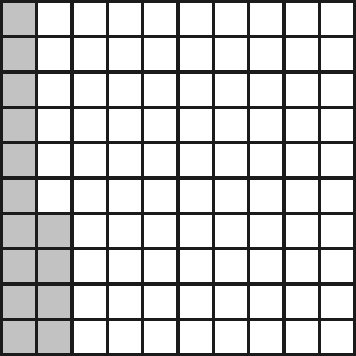
2.2

2.3
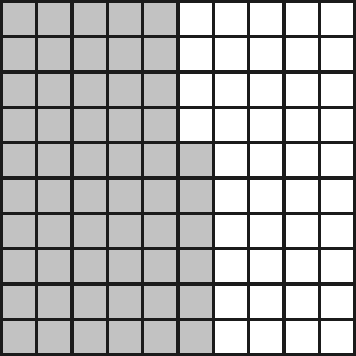
2.4
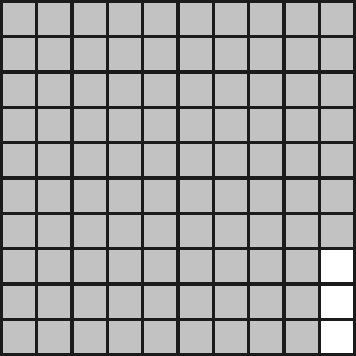
2.5
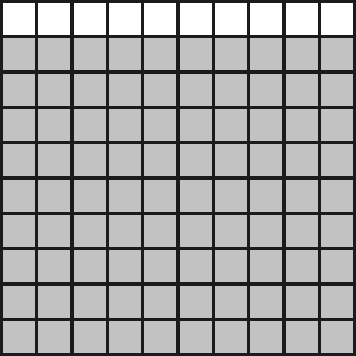
2.6
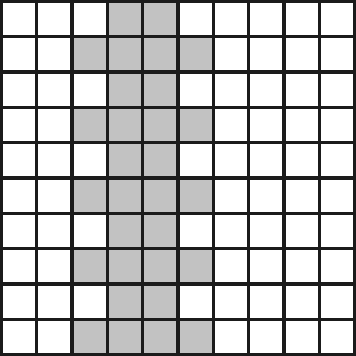
| Learning outcomes(LOs) |
| LO 1 |
| Numbers, Operations and RelationshipsThe learner is able to recognise, describe and represent numbers and their relationships, and to count, estimate, calculate and check with competence and confidence in solving problems. |
| Assessment standards(ASs) |
| We know this when the learner: |
| 1.3 recognises and represents the following numbers in order to describe and compare them: |
| 1.3.3 decimal fractions of the form 0,5; 1,5; 2,5, and so on, in the context of measurement; |
| 1.5 recognises and uses equivalent forms of the numbers listed above, including: |
| 1.5.2 decimal fractions of the form 0,5, 1,5 and 2,5, and so on, in the context of measurement; |
1.6 solves problems in context including contexts that may be used to build awareness of other Learning Areas, as well as human rights, social, economic and environmental issues such as:
|
1.8 estimates and calculates by selecting and using operations appropriate to solving problems that involve:
|
| 1.9 performs mental calculations involving:1.9.1 addition and subtraction;1.9.2 multiplication of whole numbers to at least 10 x 10; |
1.10 uses a range of techniques to perform written and mental calculations with whole numbers including:
|
| 1.11 uses a range of strategies to check solutions and judge the reasonableness of solutions; |
ACTIVITY 1
1. 1.1:
1.2:
1.3:
2. 2.1: 0,03
2.3: 0,9
3. ; ; ; ; ; ; ;
0,3; 0,7; 0,9; 1,2; 1,3
4. 4.1: 31,5
5. 5.1: 0,8; 1; 1,2; 1,4; 1,6
5.2: 4,1; 3,9; 3,7; 3,5; 3,3
5.3: 2,5; 3,5; 4,5; 5,5; 6,5
5.4: 2,8; 2,4; 2; 1,6; 1,2
5.5: 9; 8,9; 8,8; 8,7; 8,6
ACTIVITY 2
1.1: 4,3; 4,9; 5,5; 6,1; 6,7; 7,3; 7,9; 8,5; 9,1; 9,7
1.2: 8,9; 8,5; 8,1; 7,7; 7,3; 6,9; 6,5; 6,1; 5,7; 5,3
ACTIVITY 3
1. 1.1: /
2. 2.1: 0,8
3. Change denominator to 10 or 100 (equivalent fractions)
4. Numerator + denominator =
ACTIVITY 4
12. 1.1: 57; 1.11: 40
ACTIVITY 5
1. 1.1: R0,04
2. 2.1: = 0,86
2.2 = 0,72
2.3 = 0,44
2.4 : = 0,03
2.5: = 0,10
2.6 : = 0,70

Notification Switch
Would you like to follow the 'Mathematics grade 5' conversation and receive update notifications?